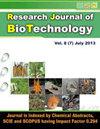Free amino acid profiling and quantification of 4-hydroxyisoleucine in Trigonella foenum-graecum (fenugreek) seeds treated with Trichoderma viride and rhizobium
IF 0.2
Q4 BIOTECHNOLOGY & APPLIED MICROBIOLOGY
引用次数: 0
Abstract
Fenugreek is a legume but regarded as a poor nitrogen fixer. The present study deals with the marked effect of Trichoderma viride and rhizobium on quantification of 4-hydroxyisoleucine content and free amino acid composition of fenugreek seeds. 4-hydroxyisoleucine is regarded as an antidiabetic compound present specifically in fenugreek plants. Fenugreek seeds treated with both T.viride and rhizobium boosted free amino acid concentration and 4-hydroxyisoleucine content compared to control and positive control (NPK treated). Seeds were treated with T.viride suspension (107 spores/seed), rhizobium suspension (108 cells/seed) , combination of T.viride and rhizobium suspension in equal amounts (0.5ml of T.viride 0.5ml of rhizobium suspension /seed), NPK suspension ( 1ml NPK suspension / seed) and untreated seeds (1 ml distilled water/ seed) serving as control sown in pots filled with potting soil and also in a randomized plot ( 55 feet) in the field. In free amino acid composition, isoleucine is the precursor for 4-hydroxyisoleucine compound and its concentration was enhanced by 47.79 % (potted plants) and 26.46 % (field plants) over control and by 27.02 % (potted plants) and 13.03 % (field plants) over positive control. 4-hydroxyisoleucine content was quantified using LCMS method in both potted and field plants. An increase of 37.02 % (potted plants) and 23.61 % (field plants) in 4-hydroxyisoleucine concentration in dual treated plants over control and positive control was observed.用病毒毛霉和根瘤菌处理的葫芦巴种子中的游离氨基酸谱分析和 4-羟基异亮氨酸的定量分析
胡芦巴是一种豆科植物,但被认为固氮能力差。本研究探讨了毛霉菌和根瘤菌对葫芦巴种子中 4-羟基异亮氨酸含量和游离氨基酸组成定量的显著影响。4- 羟基异亮氨酸被认为是葫芦巴植物中特有的一种抗糖尿病化合物。与对照组和阳性对照组(氮磷钾处理)相比,用T.viride和根瘤菌处理的葫芦巴种子提高了游离氨基酸浓度和4-羟基异亮氨酸含量。种子经病毒唑悬浮液(107 个孢子/种子)、根瘤菌悬浮液(108 个细胞/种子)、病毒唑和根瘤菌等量混合悬浮液(0.5 毫升病毒唑悬浮液 0.5 毫升根瘤菌悬浮液/种子)、氮磷钾悬浮液(1 毫升氮磷钾悬浮液/种子)和未经处理的种子(1 毫升蒸馏水/种子)处理后作为对照,播种在装满盆土的花盆中,也播种在田间的随机小区(55 英尺)中。在游离氨基酸组成中,异亮氨酸是 4-羟基异亮氨酸化合物的前体,其浓度比对照提高了 47.79 %(盆栽植物)和 26.46 %(大田植物),比阳性对照提高了 27.02 %(盆栽植物)和 13.03 %(大田植物)。采用 LCMS 方法对盆栽植物和大田植物中的 4-羟基异亮氨酸含量进行了定量。与对照和阳性对照相比,经双重处理的植物中 4-羟基异亮氨酸的浓度分别增加了 37.02 %(盆栽植物)和 23.61 %(大田植物)。
本文章由计算机程序翻译,如有差异,请以英文原文为准。
求助全文
约1分钟内获得全文
求助全文
来源期刊

Research Journal of Biotechnology
BIOTECHNOLOGY & APPLIED MICROBIOLOGY-
CiteScore
0.60
自引率
0.00%
发文量
192
期刊介绍:
We invite you to contribute Research Papers / Short Communications / Review Papers:
-In any field of Biotechnology, Biochemistry, Microbiology and Industrial Microbiology, Soil Technology, Agriculture Biotechnology.
-in any field related to Food Biotechnology, Nutrition Biotechnology, Genetic Engineering and Commercial Biotechnology.
-in any field of Biotechnology related to Drugs and Pharmaceutical products for human beings, animals and plants.
-in any field related to Environmental Biotechnolgy, Waste Treatment of Liquids, Soilds and Gases; Sustainability.
-in inter-realted field of Chemical Sciences, Biological Sciences, Environmental Sciences and Life Sciences.
-in any field related to Biotechnological Engineering, Industrial Biotechnology and Instrumentation.
-in any field related to Nano-technology.
-in any field related to Plant Biotechnology.
 求助内容:
求助内容: 应助结果提醒方式:
应助结果提醒方式:


